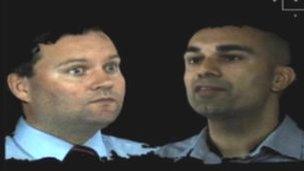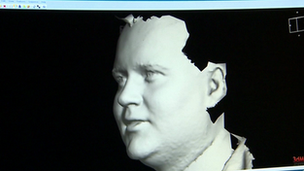3D scans boost for facial surgery at Cardiff University
- Published
The technology can also record the facial movements of people as they talk
Patients who need facial surgery and those recovering from strokes could benefit from pioneering 3D modelling of their head movements.
Scientists at Cardiff University are using cutting-edge face scanners developed by American firm 3dMD.
The technology can also record the facial movements of two individuals simultaneously while they talk.
Experts say it allows more detailed analysis than is possible by direct observation or video recordings.
Dental work
The technology converts pictures from a series of cameras into a moving 3D model of a patient's head which is then recorded.
The university's dental school is already using the technology to help surgeons treating people who need surgery such as cleft lip operations.
But it is hoped it could also be developed to provide early diagnosis of neurological conditions such as Parkinson's disease which can affect facial movements.
"In the dental school we're interested in how faces move and how lips move in relation to speech. We've been using this system to look at outcomes after surgery," said consultant orthodontist Dr Hashmat Popat.
"For example a surgeon repairing a cleft lip or palate could review the lip to make sure the muscles are connected together and functioning properly.
"But we're also looking to develop links with stroke clinicians to look at the rehabilitation of facial movements.
"And we're trying to set up links with neurologists to look at early diagnosis of Parkinson's disease - looking at how the faces of people who are at high risk of developing neurological conditions move."
Psychological insights
Researchers at computer sciences and informatics have been involved in developing the computer code that allows even tiny facial movements to be studied.

The faces of Owain Clarke and Dr Hashmat Popat are captured as they talk to each other
By linking two separate scanners together the facial expressions of two individuals can be analysed while they talk to each other which could contribute to research in psychology.
Dr Popat added: "When we're talking to each other you can see that our lips are moving. But I may have other subtle nuances around my eyes or on my forehead or around the side of my face. And the tools we have at the moment for assessing that are very crude.
"By analysing conversations we can look at how people emotionally react to each other.
"It's very exciting to be involved in pioneering research which is right at the cutting edge."
Prof David Marshall, from the university's school of computer science and informatics, said: "This is a brand new research area.
"With two systems linked together we can look at conversation expressions. We're trying to figure out how humans perceive expressions and react to them.
"So we work not only with the dentistry department but also with psychologists.
"It's a great relationship between different parts of the university. They provide us with the technical challenges which we need to solve and we provide usable code."
Close working
3dMD, the company that developed the scanners, says it is also excited by the research at Cardiff University's use of its equipment.

Creating the images is a challenge for students at the university's computer science school
Chief executive Chris Lane said: "As 3dMD develops its ground breaking technology to the next level, there has been no question that we have to work closely with the team who has had the most published research experience to date in the field of dynamic 3D applications.
"The team at Cardiff University has pushed 3dMD to make many breakthroughs, to understand and quantify the subtleties of soft tissue deformation during facial movement in babies, children and adult subjects."
The technology on which the system is based costs around £250,000.
The project was financed in part by money from the Welsh government.
However the researchers predict as cost decrease similar scanners could be rolled out more widely in clinical departments and that may mean hundreds of Welsh patients a year could benefit.
Dr Popat said: "Fifty patients a year are born with a cleft lip and palate a year in south Wales alone. And over 600 patients a year have strokes in Cardiff alone.
"So in terms of impact we eventually we could use this technology to help tens of patients a week."
- Published17 January 2012
- Published16 June 2011
- Published24 April 2012
- Published6 February 2013
- Published17 February 2013